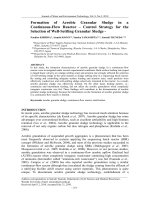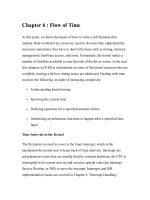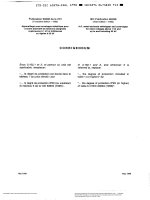C++ Basics - More Flow of Control
Bạn đang xem bản rút gọn của tài liệu. Xem và tải ngay bản đầy đủ của tài liệu tại đây (2.51 MB, 118 trang )
Copyright © 2007 Pearson Education, Inc. Publishing as Pearson Addison-Wesley
Chapter 3
More Flow of Control
Slide 3- 3
Copyright © 2007 Pearson Education, Inc. Publishing as Pearson Addison-Wesley
Overview
3.1 Using Boolean Expressions
3.2 Multiway Branches
3.3 More about C++ Loop Statements
3.4 Designing Loops
Slide 3- 4
Copyright © 2007 Pearson Education, Inc. Publishing as Pearson Addison-Wesley
Flow Of Control
Flow of control refers to the order in which
program statements are performed
We have seen the following ways to specify
flow of control
if-else-statements
while-statements
do-while-statements
New methods described in this chapter
include
switch-statements
for-statements
Copyright © 2007 Pearson Education, Inc. Publishing as Pearson Addison-Wesley
3.1
Using Boolean Expressions
Slide 3- 6
Copyright © 2007 Pearson Education, Inc. Publishing as Pearson Addison-Wesley
Using Boolean Expressions
A Boolean Expression is an expression that is
either true or false
Boolean expressions are evaluated using
relational operations such as
= = , < , and >= which produce a boolean value
and boolean operations such as
&&, | |, and ! which also produce a boolean value
Type bool allows declaration of variables that
carry the value true or false
Slide 3- 7
Copyright © 2007 Pearson Education, Inc. Publishing as Pearson Addison-Wesley
Boolean expressions are evaluated using values
from the Truth Tables in
For example, if y is 8, the expression
!( ( y < 3) | | ( y > 7) )
is evaluated in the following sequence
Display 3.1
! ( false | | true )
! ( true )
false
Evaluating Boolean Expressions
Slide 3- 8
Copyright © 2007 Pearson Education, Inc. Publishing as Pearson Addison-Wesley
Order of Precedence
If parenthesis are omitted from boolean
expressions, the default precedence of
operations is:
Perform ! operations first
Perform relational operations such as < next
Perform && operations next
Perform | | operations last
Slide 3- 9
Copyright © 2007 Pearson Education, Inc. Publishing as Pearson Addison-Wesley
Display 3.2
Precedence Rules
Items in expressions are grouped by precedence
rules for arithmetic and boolean operators
Operators with higher precedence are
performed first
Binary operators with equal precedence are
performed left to right
Unary operators of equal precedence are
performed right to left
Slide 3- 10
Copyright © 2007 Pearson Education, Inc. Publishing as Pearson Addison-Wesley
Precedence Rule Example
The expression
(x+1) > 2 | | (x + 1) < -3
is equivalent to
( (x + 1) > 2) | | ( ( x + 1) < -3)
Because > and < have higher precedence than | |
and is also equivalent to
x + 1 > 2 | | x + 1 < - 3
Slide 3- 11
Copyright © 2007 Pearson Education, Inc. Publishing as Pearson Addison-Wesley
Evaluating x + 1 > 2 | | x + 1 < - 3
Using the precedence rules of Display 3.2
First apply the unary –
Next apply the +'s
Now apply the > and <
Finally do the | |
Slide 3- 12
Copyright © 2007 Pearson Education, Inc. Publishing as Pearson Addison-Wesley
Short-Circuit Evaluation
Some boolean expressions do not need to be
completely evaluated
if x is negative, the value of the expression
(x >= 0) && ( y > 1)
can be determined by evaluating only (x >= 0)
C++ uses short-circuit evaluation
If the value of the leftmost sub-expression
determines the final value of the expression, the rest
of the expression is not evaluated
Slide 3- 13
Copyright © 2007 Pearson Education, Inc. Publishing as Pearson Addison-Wesley
Using Short-Circuit Evaluation
Short-circuit evaluation can be used to prevent
run time errors
Consider this if-statement
if ((kids != 0) && (pieces / kids >= 2) )
cout << "Each child may have two pieces!";
If the value of kids is zero, short-circuit evaluation
prevents evaluation of (pieces / 0 >= 2)
Division by zero causes a run-time error
Slide 3- 14
Copyright © 2007 Pearson Education, Inc. Publishing as Pearson Addison-Wesley
Type bool and Type int
C++ can use integers as if they were Boolean
values
Any non-zero number (typically 1) is true
0 (zero) is false
Slide 3- 15
Copyright © 2007 Pearson Education, Inc. Publishing as Pearson Addison-Wesley
Problems with !
The expression ( ! time > limit ), with limit = 60,
is evaluated as
(!time) > limit
If time is an int with value 36, what is !time?
False! Or zero since it will be compared to an integer
The expression is further evaluated as
0 > limit
false
Slide 3- 16
Copyright © 2007 Pearson Education, Inc. Publishing as Pearson Addison-Wesley
Correcting the ! Problem
The intent of the previous expression was
most likely the expression
( ! ( time > limit) )
which evaluates as
( ! ( false) )
true
Slide 3- 17
Copyright © 2007 Pearson Education, Inc. Publishing as Pearson Addison-Wesley
Avoiding !
Just as not in English can make things
not undifficult to read, the ! operator can
make C++ expressions difficult to understand
Before using the ! operator see if you can
express the same idea more clearly without
the ! operator
Slide 3- 18
Copyright © 2007 Pearson Education, Inc. Publishing as Pearson Addison-Wesley
bool Return Values
A function can return a bool value
Such a function can be used where a boolean
expression is expected
Makes programs easier to read
if (((rate >=10) && ( rate < 20)) || (rate == 0))
is easier to read as
if (appropriate (rate))
If function appropriate returns a bool value based
on the the expression above
Slide 3- 19
Copyright © 2007 Pearson Education, Inc. Publishing as Pearson Addison-Wesley
Function appropriate
To use function appropriate in the if-statement
if (appropriate (rate))
{ … }
appropriate could be defined as
bool appropriate(int rate)
{
return (((rate >=10) && ( rate < 20)) || (rate == 0));
}
Slide 3- 20
Copyright © 2007 Pearson Education, Inc. Publishing as Pearson Addison-Wesley
Enumeration Types (Optional)
An enumeration type is a type with values
defined by a list of constants of type int
Example:
enum MonthLength{JAN_LENGTH = 31,
FEB_LENGTH = 28,
MAR_LENGTH = 31,
…
DEC_LENGTH = 31};
Slide 3- 21
Copyright © 2007 Pearson Education, Inc. Publishing as Pearson Addison-Wesley
Default enum Values
If numeric values are not specified, identifiers
are assigned consecutive values starting with 0
enum Direction { NORTH = 0, SOUTH = 1,
EAST = 2, WEST = 3};
is equivalent to
enum Direction {NORTH, SOUTH, EAST,
WEST};
Slide 3- 22
Copyright © 2007 Pearson Education, Inc. Publishing as Pearson Addison-Wesley
Enumeration Values
Unless specified, the value assigned an
enumeration constant is 1 more than the previous
constant
Enum MyEnum{ONE = 17, TWO, THREE,
FOUR = -3, FIVE};
results in these values
ONE = 17, TWO = 18, THREE = 19,
FOUR = -3, FIVE = -2
Slide 3- 23
Copyright © 2007 Pearson Education, Inc. Publishing as Pearson Addison-Wesley
Section 7.1 Conclusion
Can you
Write a function definition for a function named
in_order that takes three arguments of type int?
The function returns true if the arguments are in
ascending order; otherwise, it returns false.
Determine the value of these Boolean expressions?
Assume count = 0 and limit = 10
(count == 0) && (limit < 20)
!(count == 12)
(limit < 0) && ((limit /count) > 7)
Copyright © 2007 Pearson Education, Inc. Publishing as Pearson Addison-Wesley
3.2
Multiway Branches
Slide 3- 25
Copyright © 2007 Pearson Education, Inc. Publishing as Pearson Addison-Wesley
Multiway Branches
A branching mechanism selects one out of a
number of alternative actions
The if-else-statement is a branching
mechanism
Branching mechanisms can be a subpart of
another branching mechanism
An if-else-statement can include another
if-else-statement as a subpart









